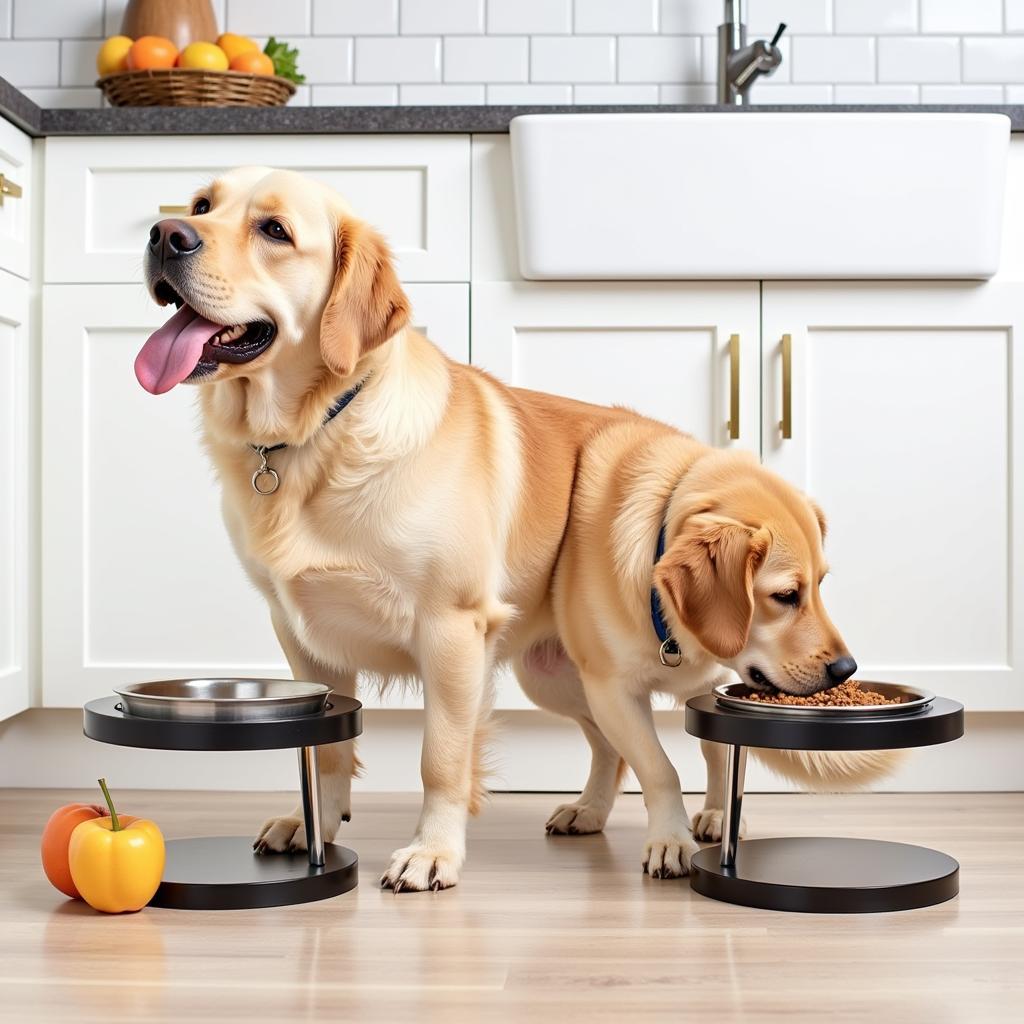Finding the perfect food bowl height for your furry friend can significantly impact their comfort and overall health. But how tall should my dog’s food bowl be? The answer isn’t one-size-fits-all, but rather depends on your dog’s breed, size, and even age. Choosing the correct height can prevent digestive issues, joint pain, and even encourage better eating habits.
Understanding the Importance of Proper Food Bowl Height
Elevated food bowls aren’t just a trendy accessory; they offer real benefits for your dog’s wellbeing. For larger breeds, eating from ground level can strain their necks and backs, leading to discomfort and potential long-term issues. Smaller dogs, while not as susceptible to these issues, can still benefit from a slightly raised bowl, making mealtimes easier and more enjoyable.
 Elevated Dog Bowl Benefits
Elevated Dog Bowl Benefits
Determining the Ideal Height: A Tailored Approach
So, how do you figure out the right height for your dog’s food bowl? A good rule of thumb is to measure your dog’s withers (the highest point of their shoulder blades) and subtract a few inches. This allows them to eat comfortably without stooping too low or stretching too high. For puppies and senior dogs, consider further adjustments based on their individual needs. You can even create a DIY dog food and water station tailored to their height.
Considerations for Different Breeds and Sizes
- Large Breeds: Great Danes, German Shepherds, and other large breeds often benefit significantly from elevated feeders. A wall mount dog food dispenser can also be a great option for larger breeds, especially if space is a concern.
- Medium Breeds: While not as crucial as for large breeds, a slightly raised bowl can still improve comfort for medium-sized dogs.
- Small Breeds: Small dogs might only need a slightly raised bowl, especially if they have short legs or are prone to breathing difficulties. Look into appropriate low purine dog food options to support their overall health.
- Puppies: Start with a lower elevation and gradually increase the height as your puppy grows.
- Senior Dogs: Arthritis and other age-related conditions can make it difficult for senior dogs to bend down. A raised bowl can make mealtimes much easier and less painful. For specific breed concerns like bulldog food allergies, adjust food content as necessary.
 Measuring Dog for Food Bowl
Measuring Dog for Food Bowl
“Proper bowl height is crucial for a dog’s long-term health. It can prevent a range of issues, from megaesophagus to joint pain,” says Dr. Emily Carter, a veterinary specialist in canine nutrition. “A comfortable eating posture promotes better digestion and overall well-being.”
Recognizing the Signs of an Improper Bowl Height
If your dog displays signs of discomfort while eating, such as coughing, gagging, or reluctance to eat, the height of their food bowl might be the culprit. Other signs include neck pain, regurgitation, and difficulty swallowing.
Choosing the Right Type of Elevated Food Bowl
Various types of elevated dog bowls are available on the market, from simple stands to elaborate multi-bowl systems. Consider your dog’s size, eating habits, and any specific needs when making your choice. Opt for sturdy, easy-to-clean materials.
“Investing in a good quality elevated food bowl can make a world of difference for your dog’s health and happiness,” adds Dr. Carter. “It’s a small change that can have a big impact.” Remember to choose bison dog food that compliments their nutritional needs.
Conclusion
Choosing the right height for your dog’s food bowl is a simple yet significant step in ensuring their comfort and overall health. By considering your dog’s individual needs and following the guidelines outlined above, you can create a more enjoyable and healthier dining experience for your furry companion. Remember, finding the perfect height for your dog’s food bowl is crucial for their long-term well-being.
FAQ
- Can I use a regular bowl on a stand? Yes, as long as the stand is stable and raises the bowl to the appropriate height.
- Are elevated bowls suitable for all dogs? While most dogs benefit, consult your vet if your dog has specific mobility issues.
- What material is best for elevated bowls? Stainless steel and ceramic are durable and hygienic options.
- How often should I clean my dog’s food bowl? Daily cleaning is recommended to prevent bacterial growth.
- Can raised bowls prevent bloat? While not a guaranteed preventative measure, they can help reduce the risk in some breeds.
- Are there adjustable height bowls? Yes, some bowls come with adjustable legs to accommodate different sizes and needs.
- Can I make my own elevated food bowl? Yes, DIY options are available and can be customized to your dog’s height.
Common Scenarios
- Scenario 1: A Great Dane struggling to eat from a bowl on the floor.
- Scenario 2: A senior Chihuahua with arthritis finding it difficult to bend down to eat.
- Scenario 3: A puppy outgrowing its current food bowl height.
Further Reading and Resources
- Explore more about dog nutrition and feeding practices.
- Find out about different types of dog food bowls.
- Learn about creating a comfortable eating environment for your dog.
Need help choosing the perfect food bowl? Contact us at Phone Number: 02437655121, Email: minacones@gmail.com or visit us at 3PGH+8R9, ĐT70A, thôn Trung, Bắc Từ Liêm, Hà Nội, Việt Nam. We have a 24/7 customer support team.